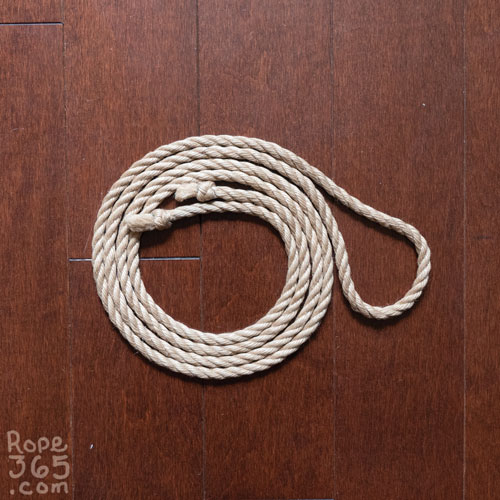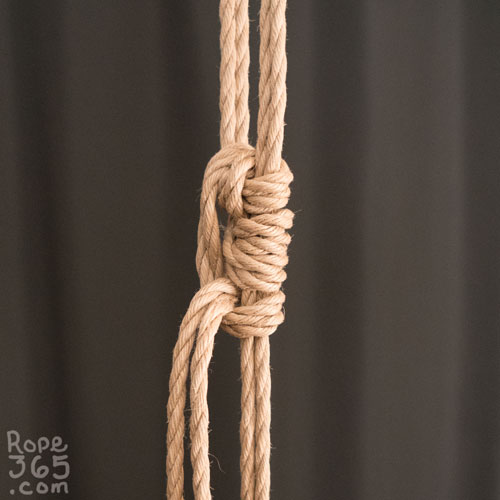Week 31: More Hitches
Hitches, the knots that bind a rope to another rope or object, is a very wide family. In Week 2 we looked at 7 different hitches and it can be useful to add more to the toolbox. Each hitch has interesting properties and many variations can find a purpose in rope play.
The goal of this week is to expand our toolbox and explore the many possibilities of more specialized hitches.
Note – this page is a sample of the rope365 content. Subscribe to the mailing list to get notified when the full content gets published.

Day 211: Multi-Loop Hitches – Single column ties, clove hitches or larks’ head allow to start a tie on any limb or rope, but what if we want to attack to multiple places in a single hitch? Multi-loops hitches allows just that, this can be used to spread the load on several points on the body. The Y hanger is a popular knot that attaches to two locations at the same time, and there are a few variations of it. Can you create a knot that attaches to 3+ points at the same time? |

Day 212: More Inline Cuffs – We looked at the half hitch inline cuff in Day 12, the cow hitch cuff in Day 13 and a quick release cuff in Day 14. Many knots can be used to create cuffs. It is particularly interesting to create a cuff that doesn’t require tension to be stable such as the reverse Somerville bowline and the captured overhand cuff. Inspirations and Resources
|

Day 213: Friction Hitches – Sometimes we want to have a pulley system with just a bit of friction to help to maintain control and prevent the rope from sliding too fast without locking completely. The Munter hitch is a very popular hitch to use in those situations. Because of the similar topology between the Munter and the crossing hitch from Day 10, many people see them as the same hitch. The Munter hitch was originally designed to be used in belay systems to add friction on moving rope, while the crossing hitch is designed to hold things in place and prevent movement. Inspirations and Resources |

Day 214: More Locks – In Day 4 we looked at the clove hitch and two half hitches to lock things in place. Many more combinations of basic hitches can create a lock as well. A Munter hitch followed by a half hitch, a half hitch on each side of a stem (forming a cow hitch), a cleat hitch (clove hitch variation). You can also explore with splitting the ends, from there you continue to tie before tying it off with half knots or with a shoelace bow. Inspirations and Resources |

Day 215: Grippy Hitches – These hitches will tighten to remain in place and are great to create an attachment point on slippery surfaces. It’s fascinating how rope can hold on a slick dance pole with the right hitch. Using these hitches on the body will create a cuff that tightens, this can be fun as long as we are mindful of the safety aspect of it. We should avoid these hitches for safety lines as they can fail catastrophically when tension is removed. |

Day 216: Adjustable Hitches – These hitches can slide after having been tied. These are really practical when tying something that is likely to need to be adjusted afterward, when the level of tension needs to be at a great degree of precision, or just to have fun changing things without having to untie and retie. |

Day 217: More Quick Release – In Day 14 we learned a quick release knot based on the slipped half hitch. Let’s explore other techniques to create quick releases such as the Farrimond hitch (both an adjustable hitch and a quick release at the same time), or the tumble hitch that also uses up the excess of rope at the same time. |
Gallery
Inspirations and Resources
- Ringbolt hitch by Tying It All Together
- Ringbolt hitch futumomo by Zylah
- Trucker’s hitch by Animated Knot
- Trucker’s hitch by Ylvis – Not a tutorial
- Portfolio by Windy Chien
Or return to Fall for more options.
Credit: R/P: Ebi McKnotty


Leave a Reply